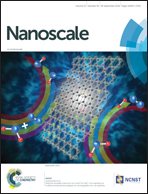Human-based fibrillar nanocomposite hydrogels as bioinstructive matrices to tune stem cell behavior†
Abstract
The extracellular matrix (ECM)-biomimetic fibrillar structure of platelet lysate (PL) gels along with their enriched milieu of biomolecules has drawn significant interest in regenerative medicine applications. However, PL-based gels have poor structural stability, which severely limits their performance as a bioinstructive biomaterial. Here, rod-shaped cellulose nanocrystals (CNC) are used as a novel approach to modulate the physical and biochemical microenvironment of PL gels enabling their effective use as injectable human-based cell scaffolds with a level of biomimicry that is difficult to recreate with synthetic biomaterials. The incorporation of CNC (0 to 0.61 wt%) into the PL fibrillar network during the coagulation cascade leads to decreased fiber branching, increased interfiber porosity (from 66 to 83%) and modulates fiber (from 1.4 ± 0.7 to 27 ± 12 kPa) and bulk hydrogel (from 18 ± 4 to 1256 ± 82 Pa) mechanical properties. As a result of these physicochemical alterations, nanocomposite PL hydrogels resist the typical extensive clot retraction (from 76 ± 1 to 24 ± 3 at day 7) and show favored retention of PL bioactive molecules. The feedback of these cues on the fate of human adipose-derived stem cells is evaluated, showing how it can be explored to modulate the commitment of encapsulated stem cells toward different genetic phenotypes without the need for additional external biological stimuli. These fibrillar nanocomposite hydrogels allow therefore the exploration of the outstanding biological properties of human-based PL as an efficient engineered ECM which can be tailored to trigger specific regenerative pathways in minimal invasive strategies.



 Please wait while we load your content...
Please wait while we load your content...